#olecranon fracture
Explore tagged Tumblr posts
Text
A Few Fight Injuries
I've talked a lot about various injuries someone might get from a fight (all found here), and now I'll ramble on about them some more.
Fight Bite (closed fist bites)
The name is silly, but this injury happens when you punch someone in the face. Teeth are sharp, and you will cut your hand on them. This is always gross, but it's specifically a problem when that tooth punctures the metacarpophalangeal joint (your big knuckle that you hit people with). Human mouths are really fucking dirty, and all that shit gets inside when the skin is pierced. This can be anything from bacteria (most commonly Streptococcus viridians, S. pyogenes, or Staph aureus) to viruses like HIV or hepatitis (though this is rare). Either way, it's nasty and you need to clean that shit out.
Swelling, pain, tenderness, fever, etc. are the common symptoms. You'll need to get it taken care of and get on some antibiotics. Also, these can be missed even by healthcare providers, or seen as just another cut on the skin. This is why doing a thorough physical exam is always important!
Boxers' Fracture (metacarpal neck fracture)
This happens when you break the head off of your fourth or fifth (ring and pink fingers) metacarpal bones (the ones in your hand) cause you're a stupid fuck who doesn't know how to punch correctly. These are some weak ass bones, so when you get pissed off and punch the wall like a dumbass, they snap like slim jims. This is the most common hand injury, and typically shows no motor deficits (though it will hurt like a motherfucker). There may also be some deformity or shortening of the area.
It needs to be set and splinted, and you need to learn how to punch. You have two bigass knuckles for a reason. Use those (though they can fracture too, you just won't look as stupid in the ER).
Boxers' Knuckle
Look at the back of your hand. See the big tendon running to each finger? That's the tendon for your extensor digitorum (you have extra ones on the pinky and index fingers), it extends your fingers (obviously). Now make a fist. See how your tendon stays relatively straight over the knuckle (hopefully)? Imagine if it deviated to the side. That would suck, right? That's what boxers' knuckle is.
You have these things called sagittal bands that keep the tendon running straight as you bend your fingers. If you punch something just right, you can snap these. This will cause the tendon to deviate with a snapping motion as you flex your fingers. It also causes pain and swelling, the usual. To fix this, you need surgery.
An important thing to note if you've ever done some kind of martial art that required knuckle training, is that even if you get tendonitis, the tendon should always stay straight. You may have some rigidity as you train, but if it is super painful, lasts a long time, or causes deviation, see a doctor. You can seriously fuck up your hands if you go out and try to get Bruce Lee knuckles if you don't know what you're doing.
Olecranon Fracture
The olecranon is the end of your ulna and the big bony part of your elbow. You can break it if you land on it. If you've ever seen a professional fight, you might notice people will slap the mat if they fall on their ass. This is something that is taught so that they won't try to post on their elbow. If you fall backwards (like when someone grabs your leg or sweeps it) and you land on your elbow, you can just fuck the shit out of your olecranon.
You can either crack it, or you can completely break the end of your elbow off and have to get it surgically reattached. Even if you don't break it, you can damage a lot of the nerves, vessels, or tendons that attach there. Point is, don't post on your elbow like a dumbass. Don't post on your hand, either. Or your head. Actually, just try not to get in a fight if you don't know what you're doing.
End Notes
Okay, story time. I know a lot of people who have broken their elbow by posting on it. Like idk if it's just common in my jiu-jitsu scene or if it's common everywhere, but there's like three guys at my gym who have done it. Also, the last time I sparred with my dad, I blocked a kick, and he landed on his ass and elbow. He didn't break it, but he did tear a ligament. We weren't allowed to spar after that :/ So yeah, don't do it, please. You are not built different, lol.
#medicine#med studyblr#med student#medical school#med school#whump writing#medical writing#injuries#injury#action writing
12 notes
·
View notes
Note
How do we think John Hartnell got his injuries? They say he had a compressed vertebra, an injured ankle, a foot infection, and a shoulder injury. There doesn't seem to be any record of how these happened, and they didn't mention anything about it during his exhumation.
YES I LOVE THIS QUESTION
So there actually are some records of what happened from his forensic report from the '86 exhumation! Like a lot of things about him, it does take some guesswork until we build a time machine and study him like a bug the way I've always wanted.
Here are some selected parts of the autopsy report, which we can use to reconstruct what might have happened to him:
[About the cervical spine compression:] However, there does appear to be some compression of the superior end-plate of the body of C6, consistent with mild fracture, probably representing subacute injury. Cervical alignment is normal. There are no arthritic changes.
[About his upper shoulders and arms:] On some projections, the left acromion appears slightly tapered, possibly due to old trauma. A small spur off the posterior aspect of the left olecranon is also likely to be post-traumatic.
[About the wrists:] The wrists and hands are unremarkable, except for diffuse muscle wasting. There is mild bilateral negative ulnar variance (the distal ulna lies more proximal than the distal radius at the distal radioulnar articulation; if severe, this misalignment may predispose to avascular necrosis of the lunate). No evidence for fractures or arthritis was found.
[About the lower extremities:] The femurs appear normal. Hip and knee articulations are preserved. However, there is a slight widening of the medial aspect of the left ankle joint, raising the possibility of ligamentous injury. No fractures are noted. The talar dome and tibial plafond show no evidence for osteochondritis dissecans, an occasional sequel to subchondral injury. A few growth recovery lines (Harris lines) are noted in the lower tibial shafts. There is also some spurring off the anterior articular lip of the distal right tibia, and probably post-traumatic in origin. A more curious finding is a possible focus of cortical demineralization in the plantar aspect of the 4th metatarsal shaft of the left foot, best demonstrated on oblique projections. Actual disruption of the cortex may be present and could represent osteomyelitis. However, there were no overlying superficial ulcers or open wounds.
OKAY SO we have some key parts of these selections (parts I omitted included stuff like saying how Hartnell looked better than Braine; RIP buddy), and we also have to consider a few things in addition to these: Jartnell had already been exhumed twice before (1852 and briefly in 1984) and the earliest exhumation had done damage to his body, he had some obvious wasting from being stuck in the ice for 140+ years, and tuberculosis can damage far more than just the lungs.
What we can't be completely sure of is his family medical history, although the Inglefield & Sutherland exhumation attempt remarked that tuberculosis was "a malady to which it was further known that the deceased was prone." I haven't been able to find a clarification for this comment—I took it to either mean it was known that he'd died of TB, or it was known that he'd had TB in the past. (See: what I think his dad died from.) But we also can assume that the Harris lines in his legs show that he'd gone through some period of undernourishment at some early point in his life, which isn't too out of pocket for a Victorian working class person. Granted, he was nearly six foot tall and his brother was 5'8" (both taller than the average Victorian-era man), so his growth wasn't too arrested.
All to say that some of his forensic oddities may have come from an earlier time in his life, like an injury or a previous condition. The injury in his elbow, for instance, sounds like it came from earlier in his life. He had been a sailor on a multi-year voyage on the HMS Volage in the past, and went from a career of a shoemaker (which involved inhaling some gnarly chemicals like green vitriol/copperas, as well as repetitive motion injuries) to a full-time sailor without the benefit of training like his younger brother had. Some of those past injuries might have come from this time—workplace injuries, essentially.
The newer injuries, like the one in his neck, could have come from a wide range of sources. Consider that he did have a zinc deficiency, and some of the symptoms of this include night blindness, fatigue, and poor wound healing. He might have been more susceptible to falls, or had a delayed reaction time. The ankle injury, for instance, sounds like a bad sprain; there are a ton of different ways to screw up your ankle on a ship like that (swinging boom accident? fell off the rigging?? slipped on the ice???). The osteomyelitis in his foot might have had a correlation to this, or might have come from an older, poorly-healed injury.
However, he was healthy enough early in the voyage that he wasn't sent back to England during the check-up near Greenland. Either he hadn't presented all of these symptoms yet, or he was really good at hiding them.
This is all a long-winded, infodumpy way to say that our boy here had a medical history that would make you wince and give a sympathetic "oooooh". He was a working-class Victorian man with working-class Victorian injuries and maladies, and it's completely possible that his family history didn't help.
#franklin expedition#john hartnell#this is so rambly but i hope it helps? i feel like i answered nothing#dj stop using the passive voice challenge
32 notes
·
View notes
Note
…where it hurts.
Hermann & Newton
oooops this prompt was from May 2024...so sorry
KLANG!
"Good God, what was that?" Hermann asked over his shoulder.
"My elbow."
Hermann unhooked his cane from the lamp near his chalkboards and zipped over to Newt's side.
"Newton, are you alright?"
"Yeah," Newt chuckled and winced, holding his elbow. "I just moved kinda quickly and smashed it against the metal file cabinet. Sounded worse than it is...probably."
"You, move too fast? You astonish me. What part of your elbow did you hit? The ulnar nerve?" Hermann said, his voice full of concern.
"Nah, just the olecranon. I don't think it's fractured, just annoying."
"Ah, the noop."
"The what?" Newt said, looking up at Hermann, rubbing his elbow and laughing.
"The noop. It is, perhaps, a colloquialism."
"Yeah for real. Who says noop?"
"I do. I believe it is of Scottish origin."
Newt shook his head. "Ok man."
"Is it better?"
"Yeah, it's totally not fractured. Not even sure if it'll bruise."
"Let me see," Hermann said, gesturing that Newton should uncover his elbow.
Newton removed his hand and lifted his elbow so Hermann could get close enough to see it. Hermann leaned down, peering. Newt followed the man's gaze with his own eyes. Suddenly Hermann placed a gentle kiss on the reddened skin.
"Thanks, I couldn't reach it myself," Newton quipped, blushing despite his apparently calm voice.
Hermann's pale face was touched with pink. Newt's mouth was so close, so inviting. He closed the gap. Newt wrapped his free arm around Hermann's neck and they kissed a little deeper.
"That was a nice smooch. I should injure myself more often," Newt said when they parted, slightly breathless.
"You don't need to injure yourself for a kiss, Newton."
"Good to know," Newt said, beaming.
(prompt fill) [AO3]
12 notes
·
View notes
Text
It’s SPOOKY SCARY SKELETONS MONTH
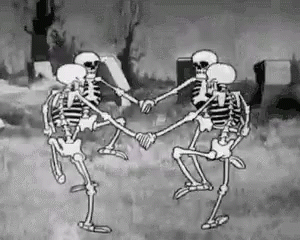
So let’s talk about yer bones! Yeah, that’s right, Captian Holt. I said –
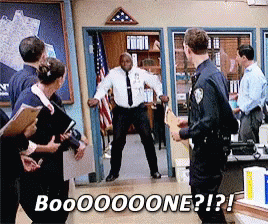
An adult has (roughly) 206 bones (I say ‘roughly’! You can have non-pathological anatomical variation, such as lumbarised sacral vertebrae (an extra bone in your back) or accessory sesamoids like the flabella (a little bone at the back of the knee!))
A newborn has (roughly) 300 bones
That's a big difference! Almost 100 bones of difference! Where do they go?
Well, you see - as you get older, every time you come into the hospital we steal more of your bones...
Just kidding.
...Or am I
As an embryo, your skeleton is completely composed of cartilage. This gradually ossifies as you age, until, as an adult, you have a full skeleton, with only the interactive portions of joints being capped with hyaline cartilage.
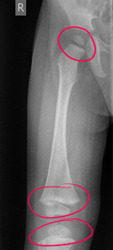
[Paediatric normal whole leg radiograph, showing epiphyseal plates around the head of the femur, the femoral condyles, the proximal tibia, the distal tibia and the lateral malleoli that can mimic fractures. Courtesy of radiopaedia]
See all those weird blobs? Those are bones in the process of fusing together! The transverse lines that could be mistaken for fractures are actually epiphyseal plates – hyaline cartilage bridges between the shaft of a bone and what will become its tip, which don't attenuate x-rays, and thus appear black on our radiographs! This is where bone growth occurs - the cartilage forms a sort of template matrix that then ossifies into bone.
Compare our paediatric radiograph to the AP knee radiographs of an adult with no visible pathology:
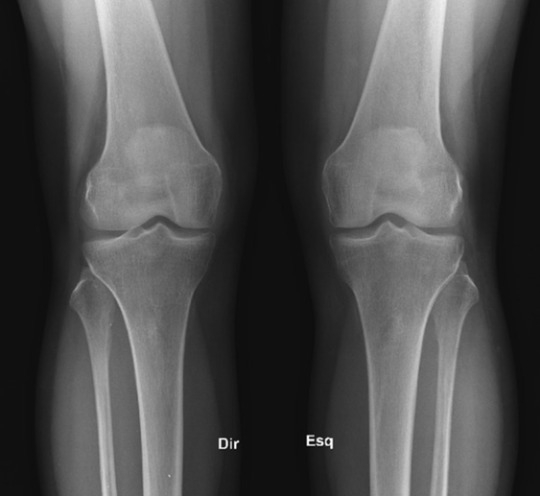
[Adult normal AP knee radiographs, showing fully fused bones. Courtesy of radiopaedia]
See how all those ragged pieces have joined up? That’s endochondral ossification, BABY!
This is how we can figure out the age of a paediatric service user from their bones! Certain bones form at different times.
Let’s check out the carpal bones – all those fiddly little bones in your wrist! Anyone who’s binged Hatecrimes MD – sorry, House MD as often as I have will know the classic acronym for remembering the names of these bones. Moving thumb side to pinkie side, we have…
Scared (Scaphoid - red)
Lovers (Lunate - dark blue)
Hate (Hamate - green)
To (Triquetrum - yellow)
Try (Trapezium - orange)
The (Trapezoid - light blue)
Coolest (Capitate - purple)
Positions (Pisiform - pink)
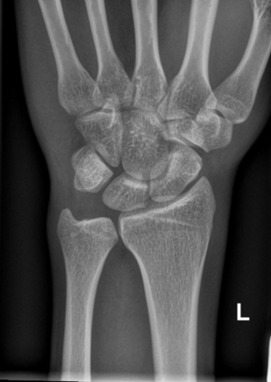
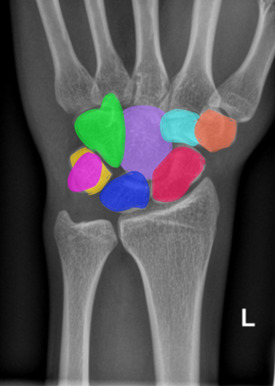
[Normal adult wrist radiograph, shown with and without coloured carpal bones. Courtesy of radiopaedia.]
But did you know that these bones form at different times?
The Capitate ossifies at 1-3 months
The Hamate ossifies at 2-4 months
The Triquetrum ossifies at 2-3 years
The Lunate ossifies at 2-4 years
The Scaphoid, Trapezium and Trapezoid ossify at 4-6 years
And the Pisiform ossifies at 8-12 years
So, I can look at this picture, and tell you that this child is approximately 3 years old, because their Capitate and Hamate have ossified, and their Triquetrum is just visible, starting to ossify below the thumb (circled!)
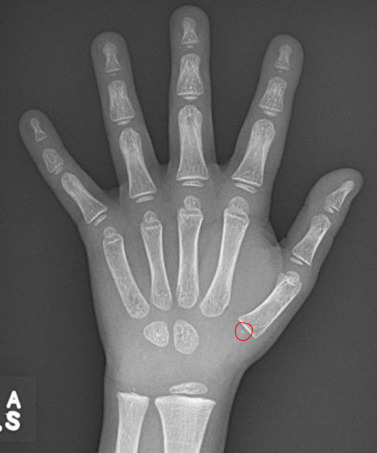
[Normal wrist radiograph of a paediatric patient, triquetral ossification centre circled. Courtesy of Radiopaedia.]
Your bones continue to form and fuse until you reach about 25! Your olecranon (the bump of your elbow) starts to ossify at 6-11 years, and fuses at 13-16 years! We can look at the base of your fifth metatarsal to age afab folks who are approx. 10 and amab folks who are approx. 12, as this bone fuses in the 2-4 years following these ages! The medial end of the clavicle can be used to assess your age from approximately 18-22, and your facial bones continue to ossify into adulthood! How cool is that?
If you’re over 25, fret not – there’s still plenty of funky stuff happening to your bones. But we’ll get into all of that next time, when we take a look at the function of osteoblasts and osteoclasts and explore all the cool little jobs that your bones perform within your body - it's more than you might think! So, tune in next time for more Bone facts...
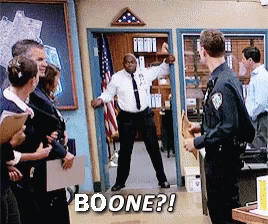
And thank you for reading!
#medblr#halloween#spooky#skeleton#science side of tumblr#radiography#radiology#medicine#human anatomy#x rays#radley irradiates people#spoopy
33 notes
·
View notes
Text
me when i shatter tf out of my ulna

“acute comminuted fracture of olecranon with 1.7 cm of distraction” <33
happened february 1st <33 three days in the hospital,, and was $288,439 <33 i love the american healthcare system
on a cooler note i now have 7 screws in my arm
2 notes
·
View notes
Note
Weird question, but if someone's elbow was broken by just like bending it over backwards until it gives way, what kind of damage would you be looking at, and how might it be treated?
Here is the anatomy of the elbow:

If the elbow was bent backwards, you would probably see torn tendons and ligaments, a fracture of the olecranon (tip of the ulna, hard point of the elbow) or heads of the radius or humerus, or a rupture of the joint space. This would manifest as pain, swelling, bruising, inability to move the elbow and the arm below it, and numbness if nerves were damaged.
An elbow fracture can heal with splinting, but with extensive and complex damage, surgery such as joint replacement would probably be required, followed by physical therapy. The patient will have to wear the sling for a few weeks after the surgery. The affected elbow may be left weaker after the injury and recovery.
Happy whumping!
1 note
·
View note
Text
The Complete Guide to Treating Elbow Fractures: From Diagnosis to Healing at Shri Bone & Joint Clinic
Introduction:
Elbow fractures can be painful and debilitating, significantly affecting mobility and daily activities. Whether caused by a fall, sports injury, or accident, an elbow fracture requires prompt diagnosis and effective treatment to ensure a smooth recovery. Shri Bone & Joint Clinic specializes in comprehensive elbow fracture treatment offering advanced medical care to help patients regain strength and function. This guide covers everything you need to know about elbow fractures, from diagnosis to recovery.
Understanding Elbow Fractures
A fracture can occur in any of these bones due to trauma, leading to pain, swelling, stiffness, and difficulty in movement. Common types of elbow fractures include:
Radial Head Fractures: Often caused by falling on an outstretched hand.
Olecranon Fractures: Occur at the bony tip of the elbow and often require surgery.
Distal Humerus Fractures: Common in children and elderly individuals, sometimes requiring surgical intervention.
Symptoms of an Elbow Fracture
Patients with an elbow fracture typically experience:
Severe pain in the elbow
Swelling and bruising around the joint
Deformity in severe cases
Limited or no movement in the arm
Numbness or tingling, indicating nerve involvement
Diagnosis of Elbow Fractures at Shri Bone & Joint Clinic
Accurate diagnosis is crucial for effective treatment. At Shri Bone & Joint Clinic, our specialists use advanced diagnostic techniques, including:
X-rays: Identifying the location and severity of the fracture.
CT Scans or MRI: In complex cases, these imaging techniques provide a detailed view of the injury.
Treatment Options for Elbow Fractures
Fractures are treated differently based on their type and severity. Our clinic offers both non-surgical and surgical options tailored to each patient’s condition.
Non-Surgical Treatment
Immobilization: A splint or cast keeps the elbow stable while the bone heals.
Pain Management: Medications help control pain and inflammation.
Physical Therapy: Once healing begins, exercises restore mobility and strength.
Surgical Treatment
For severe or displaced fractures, surgery may be required. Our orthopedic surgeons at Shri Bone & Joint Clinic are experts in:
Open Reduction and Internal Fixation (ORIF): Using plates, screws, or pins to stabilize the bones.
Elbow Replacement Surgery: In extreme cases, a prosthetic implant may be necessary.
Minimally Invasive Techniques: Advanced procedures that promote faster recovery and reduce scarring.
Recovery and Rehabilitation
Healing from an elbow fracture takes time and requires proper rehabilitation. At Shri Bone & Joint Clinic, we offer personalized recovery plans, including:
Guided Physiotherapy: Strengthening and mobility exercises.
Pain Management Strategies: Medications and alternative therapies.
Lifestyle Modifications: Guidance on activities to avoid until full recovery.
Why Choose Shri Bone & Joint Clinic?
If you are seeking the best Elbow fracture treatment in Chennai, Shri Bone & Joint Clinic is the premier choice. Here’s why:
Experienced Specialists: Our team of orthopedic experts has years of experience in treating elbow fractures.
Comprehensive Care: From initial consultation to post-surgical rehabilitation, we provide holistic treatment.
Personalized Approach: Every patient receives a tailored treatment plan to ensure optimal recovery.
Excellent Patient Care: Our compassionate and professional staff ensures a comfortable healing journey.
Conclusion:
Elbow fractures require prompt medical attention and a structured treatment plan for successful healing. At Shri Bone & Joint Clinic, we are dedicated to providing the best Elbow fracture treatment in Chennai, ensuring that our patients recover with minimal discomfort and maximum efficiency. If you or a loved one is dealing with an elbow fracture visit Shri Bone & Joint Clinic for expert care and a smooth recovery.
Get More Information:
Email Us:[email protected]
Phone Number:(+91)-9363 600 206
Address:#1, 2nd Main Road, Nehru Nagar, Adyar, Chennai – 20.
Website:sbjortho.com
0 notes
Text
Elbow Injuries and Family Chiropractic Care in Scotch Plains – Health and Fitness Professionals
If you’re dealing with discomfort or injuries, whether it’s from baseball elbow pain or persistent hip aches, it can feel frustrating and limiting. At Health and Fitness Professionals in Scotch Plains, we understand the impact of these issues. That’s why we provide a range of tailored services, including physical therapy and chiropractic care, to help you recover, regain strength, and return to doing what you love.

This post will explore common Baseball elbow injuries Scotch Plains, the benefits of family chiropractic care, and physical therapy for hip pain, with expert advice on when and how to seek treatment in Scotch Plains.
Common Baseball Elbow Injuries and How to Address Them
Do you or a family member play baseball in Scotch Plains? If so, you’re likely aware that elbow injuries is one of the most common issues players encounter. The repetitive throwing motion places stress on your elbow joint, which can lead to overuse injuries.
Typical Baseball Elbow Injuries
Here are a few common conditions you might encounter:
Medial Epicondylitis (Thrower’s Elbow): This involves inflammation of tendons on the inside of the elbow. It often results from repetitive throwing motions.
Ulnar Collateral Ligament (UCL) Injuries: The UCL may become strained or torn due to overuse, especially in pitchers.
Olecranon Stress Fractures: These occur when repeated stress causes a small crack in the bone at the tip of the elbow.
Symptoms to Watch For
If you experience any of the following symptoms while playing baseball, it may be time to seek help:
Pain or tenderness around the elbow
Reduced range of motion
Instability in the joint
Swelling or bruising
Difficulty gripping or throwing objects
Treatment Options in Scotch Plains
At Health and Fitness Professionals, we are equipped to guide you through the recovery process:
Chiropractic Adjustments: Family chiropractic in Scotch Plains can alleviate joint stress and promote natural healing.
Physical Therapy: Targeted exercises can strengthen the affected area and restore mobility, while preventing future injuries.
Rest and Recovery Planning: We’ll create a plan tailored to your activity level to ensure proper healing.
The Importance of Family Chiropractic in Scotch Plains
Family Chiropractic in Scotch Plains a holistic approach to health. Whether you’re dealing with acute sports injuries or long-term discomfort, chiropractors focus on restoring your body’s balance through non-invasive methods.
Here’s why Chiropractic Care is Beneficial:
Pain Relief: From spinal alignment to joint adjustments, chiropractic care can ease pain in multiple areas, including your elbows and hips.
Improved Mobility: Regular adjustments help restore range of motion, improving your overall flexibility and activity level.
Support for the Whole Family: Family chiropractic services in Scotch Plains cater to everyone, from young athletes to older adults managing chronic conditions.
Imagine being able to sit down without back pain or play catch with your kids again—it’s possible with the right care.
Physical Therapy for Hip Pain in Scotch Plains
Are you struggling with hip pain that interrupts your usual activities? You’re not alone. Hip issues can arise from various causes, including injury, arthritis, or overuse. At Health and Fitness Professionals, we specialize in Physical therapy for hip pain Scotch Plains.
What Causes Hip Pain?
Some common causes include:
Labral Tears: These occur in the cartilage that surrounds your hip socket, often due to repetitive motion or trauma.
Tendinitis: This is inflammation of the tendons in your hip, which can result from overuse or poor movement patterns.
Arthritis: Osteoarthritis in the hip joint can lead to stiffness, discomfort, and reduced mobility.
How Physical Therapy Can Help
Physical therapy at Health and Fitness Professionals focuses on personalized treatment plans. Here’s what to expect:
Strengthening Programs: Build muscle around the hip joint to support its function.
Manual Therapy: Mobilization techniques to release tension and restore motion.
Education: Learn proper movement patterns to prevent reinjury.
Pain Management: Modalities such as ice, heat, and ultrasound to reduce pain during recovery.
Many of our patients notice significant improvements after just a few sessions—and we’re committed to helping you feel your best.
Why Choose Health and Fitness Professionals?
At Health and Fitness Professionals in Scotch Plains, we pride ourselves on delivering tailored care to every patient. Whether you’re a high performer on the baseball field or a parent juggling daily responsibilities, our team works to bring you:
Expert Guidance: With years of experience, we provide proven solutions for issues like baseball elbow injuries and hip pain.
Comprehensive Services: From family chiropractic care to focused physical therapy, we tailor every treatment to meet your needs.
A Supportive Environment: We’re here for the Scotch Plains community, helping you feel comfortable and cared for at every step.
You deserve to live pain-free. And with our expert-led treatments, it’s 100% achievable.
Take the First Step toward Recovery
Don’t wait for your discomfort to slow you down further. Whether you're tackling baseball elbow injuries in Scotch Plains, seeking family chiropractic care, or exploring physical therapy for hip pain, Health and Fitness Professionals is here to guide you on your wellness journey.
Call us today to schedule your appointment or simply [book an appointment online]. We look forward to helping you feel like yourself again—strong, mobile, and pain-free.
#Baseball elbow injuries Scotch Plains#Family Chiropractic in Scotch Plains#Physical therapy for hip pain Scotch Plains
0 notes
Text
The tricipital beak: a crucial muscle insertion point
What is the tricipital beak?
The tricipital beak is a small bony protrusion located at the upper end of the olecranon, the apophysis of the ulna (one of the bones of the forearm). This is where the tendon of the triceps brachii, the large muscle at the back of the arm responsible for elbow extension, is inserted.

What does it do?
The tricipital beak plays a fundamental role in transmitting the force generated by the triceps brachii to the elbow joint. It therefore enables the elbow to be extended powerfully and efficiently.
What pathologies are associated with the tricipital beak?
The triceps tendon can be involved in a variety of conditions, including
- Triceps tendonitis: Inflammation of the triceps tendon at its insertion on the tricipital beak can cause pain and restricted movement.
- Fracture of the tricipital beak: This type of fracture is often linked to direct trauma or a violent contraction of the triceps.
- Lateral epicondylitis: Although lateral epicondylitis (or ‘tennis elbow’) mainly affects the forearm muscles, it can sometimes be associated with triceps tendonitis.
Associated symptoms
Symptoms associated with tricipital beak pathology may vary depending on the nature and severity of the injury, but generally include :
- Pain: Localised to the elbow, often aggravated by extending the elbow against resistance.
- Swelling: Visible or palpable in the elbow.
- Redness: Sometimes present in cases of inflammation.
- Limitation of movement: Difficulty in fully extending the elbow.
Diagnosis
A doctor or specialist (orthopaedic surgeon, rheumatologist) generally diagnoses a pathology of the tricipital beak on the basis of :
- Clinical examination: Palpation of the painful area, assessment of elbow mobility and specific tests.
- Complementary examinations: X-ray, ultrasound or MRI to confirm the diagnosis and assess the extent of the injury.
Treatment
Treatment depends on the nature and severity of the injury. It may include :
- Rest: Avoid movements that aggravate the pain.
- Ice: Apply ice several times a day to reduce inflammation.
- Anti-inflammatory medication: To relieve pain.
- Physiotherapy: Specific exercises to strengthen muscles and improve elbow mobility.
- Injections: Corticosteroids in certain cases.
- Surgery: In the most serious cases, surgery may be considered. In conclusion, the tricipital beak is an essential anatomical structure for elbow function. The pathologies associated with this area can be painful and limiting, but early diagnosis and appropriate treatment generally lead to complete recovery
Go further
0 notes
Text
Sample Coded report Humerus Fracture CPT code
Medical Coding Guide Sample Coded report Humerus Fracture CPT code Pre-op Diagnosis: Closed fracture of distal left humerus Post-op Diagnosis: Same as Pre-op Procedure(s): Left – OPEN REDUCTION INTERNAL FIXATION DISTAL HUMERUS VIA OLECRANON OSTEOTOMY- Wound Class: Clean Proc. Description(s) & CPT Code(s): OPEN REDUCTION INTERNAL FIXATION DISTAL HUMERUS: Anesthesia: General Complications: none…
View On WordPress
0 notes
Text
What are Different Types of Elbow Injuries?
The elbow, a hinge joint connecting the upper and lower arms, is a vital component of our musculoskeletal system. Due to its involvement in a myriad of daily activities, ranging from simple tasks to complex athletic movements, the elbow is prone to various injuries.
That’s why, Red Stone Physio - one of the leading physiotherapy centers in NE Calgary - decided to write a quick guide on different types of elbow injuries. Read on!
Tennis Elbow (Lateral Epicondylitis)
This is a common overuse injury where the outer part of the elbow becomes painful and tender. It is often associated with repetitive gripping and wrist extension activities, rather than solely with tennis.
Golfer's Elbow (Medial Epicondylitis)
Similar to tennis elbow, golfer's elbow involves pain and inflammation, but on the inner side of the elbow. It is often caused by repetitive flexion and gripping activities, such as those performed in golfing or throwing sports.
Fractures
Elbow fractures can involve any of the three bones in the joint: the humerus, radius, or ulna. These fractures may result from falls, direct impact, or traumatic events.
Discover the best Chiropractor in NE Calgary for disorders related to the spine, pelvis, and nervous system.
Olecranon Bursitis
The olecranon bursa, a fluid-filled sac located at the tip of the elbow, can become inflamed due to trauma or repetitive pressure. This condition is known as olecranon bursitis and can result in swelling and discomfort.
Ulnar Collateral Ligament (UCL) Injury
Commonly seen in overhead athletes like baseball pitchers, UCL injuries involve damage to the ligament on the inner side of the elbow. Overuse and repetitive stress can lead to instability and pain.
Radial Head Subluxation (Nursemaid's Elbow)
This injury often occurs in young children when there is a sudden pull on the extended arm, causing the radial head to partially dislocate. It is a common pediatric elbow injury.
Cubital Tunnel Syndrome
Similar to carpal tunnel syndrome but at the elbow, cubital tunnel syndrome involves compression of the ulnar nerve. Symptoms include tingling and numbness in the ring and little fingers.
Conclusion
Proper diagnosis and treatment by a healthcare professional, often involving physical therapy or, in some cases, surgical intervention, are essential for optimal recovery from elbow injuries.
Still got questions to ask? Send them at [email protected] and get a quick reply from experienced physiotherapists in NEW Calgary.
Discover our best services:
Sports Massage in NE Calgary
Dry Needling in NE Calgary
0 notes
Text

Plate, Thickness: 2mm, Size: 6 Hole. These plates are indicated for fixation of fractures and nonunions of the Clavicle, Scapula, Olecranon, Humerus, Radius, Ulna, Pelvis, Distal tibia, and Fibula. . . .#bonito #surgitech #bonitosurgitech #smanufacturer #buisness #orthopediccare #smallplate #smalldcpplate #delhi #india
0 notes
Text
Batting A Thousand with Healthy Elbows: Managing Baseball Elbow Injuries in Freehold and Woodbridge
Introduction
Playing baseball is a cherished pastime for many in Freehold and Woodbridge. However, repeated motions can lead to elbow injuries, affecting both performance and enjoyment. This blog post aims to guide athletes, parents, and coaches on how to manage and prevent baseball elbow injuries effectively. We'll explore the causes, symptoms, preventative measures, and treatments, empowering you to keep your elbows—and your game—in top form.
Understanding Baseball Elbow Injuries
What Are Baseball Elbow Injuries?
Baseball elbow injuries freehold, often called "thrower's elbow" or "pitcher's elbow," are caused by repetitive stress on the elbow joint. These injuries result in pain and inflammation, primarily affecting young players.
Common Types of Elbow Injuries in Baseball
The most common types of elbow injuries include medial epicondylitis (pitcher's elbow), ulnar collateral ligament (UCL) injuries, and olecranon stress fractures. Each condition has unique symptoms and requires different treatment approaches.
Why Are Elbow Injuries Prevalent in Baseball?
The repeated throwing motion puts significant strain on the elbow joint. Over time, this strain can lead to micro-tears in the tendons and ligaments, causing pain and potential long-term damage if not addressed promptly.
Recognizing the Symptoms
Early Signs to Watch For
Early symptoms of a baseball elbow injury include mild discomfort, stiffness, and a decrease in throwing velocity or accuracy. Paying attention to these signs can prevent more severe damage.
When to See a Doctor
If you notice persistent pain, swelling, or difficulty moving the elbow, it's crucial to consult a healthcare professional. Early diagnosis and treatment can prevent the injury from worsening.
Diagnosing Elbow Injuries
Doctors use physical examinations, imaging tests like X-rays or MRIs, and patient history to diagnose Baseball elbow injuries Woodbridge accurately. Understanding the extent of the injury helps in tailoring the treatment plan.
Preventative Measures
Warm-Up and Stretching
A proper warm-up increases blood flow to muscles and tendons, reducing the risk of injury. Stretching exercises should focus on the shoulders, elbows, and wrists to ensure flexibility and strength.
Strengthening Exercises
Incorporating strength training into your routine can fortify the muscles around the elbow, providing better support during throws. Exercises like forearm curls, tricep extensions, and wrist flexors are highly beneficial.
Pitch Count Limits
Monitoring and limiting the number of pitches thrown in a game or practice session can significantly reduce the risk of overuse injuries. Adhering to recommended pitch counts is essential, especially for younger players.
Treatment Options
Rest and Ice
Initial treatment for minor injuries typically involves rest and ice application. Rest allows the tissue to heal, and ice reduces inflammation and pain.
Physical Therapy
Physical therapy can help restore strength and flexibility to the injured elbow. Therapists will design a program tailored to your needs, focusing on gradual improvement without further stressing the joint.
Surgical Interventions
In severe cases, surgical intervention may be necessary. UCL reconstruction, commonly known as Tommy John surgery, is one such procedure that can restore stability and function but requires a lengthy recovery period.
Rehabilitation and Recovery
Importance of a Gradual Return
Rushing back into the game can exacerbate injuries. A structured rehabilitation program ensures a gradual return to full activity, reducing the risk of re-injury.
Building a Support System
Support from coaches, teammates, and family members can significantly impact recovery. Encouragement and understanding play a crucial role in the healing process.
Monitoring Progress
Regular check-ups with a healthcare provider help monitor progress and adjust the recovery plan as needed. Being proactive about health ensures long-term success and well-being.
Role of Coaches and Parents
Educating Young Athletes
Coaches and parents should educate young athletes about the importance of injury prevention and proper techniques. Knowledgeable players are less likely to overexert themselves and more likely to report early symptoms.
Creating a Safe Playing Environment
Ensuring that the playing conditions are safe and that equipment is in good condition can prevent many injuries. Proper maintenance of fields and regular checks of gear are essential.
Encouraging Open Communication
Fostering an environment where athletes feel comfortable discussing pain and discomfort can lead to early detection and treatment of injuries. Open communication is vital for preventing long-term damage.
Community Resources in Freehold and Woodbridge
Local Clinics and Specialists
Freehold and Woodbridge boast several clinics specializing in sports injuries. Knowing where to go for expert advice and treatment can make a significant difference.
Youth Sports Programs
Participating in local youth sports programs that emphasize safety and proper techniques can help young athletes develop good habits early on. These programs often provide valuable resources and support.
Support Groups and Forums
Joining support groups or online forums can connect you with others facing similar challenges. Sharing experiences and tips can be incredibly beneficial for managing injuries and staying motivated.
The Mental Aspect of Recovery
Coping with Setbacks
Injuries can be mentally taxing, especially for passionate athletes. Developing coping strategies and maintaining a positive outlook are crucial for a successful recovery.
Staying Involved
Even if sidelined due to an injury, staying involved with the team can boost morale and maintain a sense of belonging. Attend games, offer support, and stay connected.
Setting Realistic Goals
Setting achievable goals during recovery helps maintain focus and motivation. Celebrate small victories and stay committed to the long-term process.
Success Stories
Local Heroes
Highlighting success stories from local athletes who have overcome elbow injuries can inspire and motivate those currently facing similar challenges. Real-life examples demonstrate that recovery is possible with dedication and the right approach.
Professional Athletes
Professional athletes who have successfully managed elbow injuries can serve as role models. Their experiences offer valuable insights into overcoming adversity and achieving greatness.
Personal Triumphs
Sharing personal triumphs, no matter how small, can encourage others. Every step forward is a testament to resilience and determination.
Upcoming Events and Workshops
Injury Prevention Workshops
Attending workshops focused on injury prevention can provide valuable knowledge and practical skills. These events often feature experts who offer insights into maintaining healthy elbows and overall fitness.
Community Health Fairs
Participating in community health fairs allows you to access resources and information about managing baseball injuries. These events often offer free screenings and consultations.
Training Camps
Joining training camps that emphasize proper techniques and injury prevention can enhance your skills while keeping you safe. Learning from experienced coaches and trainers is invaluable.
Conclusion
Elbow injuries are a common challenge for baseball players in Freehold and Woodbridge, but they are manageable with the right approach. By understanding the causes, recognizing symptoms, taking preventative measures, and following proper treatment protocols, you can ensure a swift recovery and a successful return to the game. Remember, staying proactive and informed is the key to maintaining healthy elbows and a thriving baseball career. For more personalized advice and support, consider booking a consultation with a local specialist or joining community programs that focus on athlete health and safety. Keep swinging, and play safe!
0 notes
Text
Elbow Strike
Hello, everyone! This is Ji Yeonwoo streaming from Yoo Hobin Company! Today, I will demonstrate three Kyokushin Karate techniques, with the help of my friend Seong Taehoon from TaehoonTaekwonTV! Please give him a warm welcome! (*-ω-)/
So far, I have been showing you street-fighting moves to end a fight!
What are they? Can you remember? If you have practised them, can you leave a short comment in this post? Thank you so much! 🙇🏻
☀️ Taehoon: Take notes from me and him. It’s bad to keep fighting for more than one minute. The longer you fight, the higher chance you’ll lose stamina and the will to fight. Remember, there’s no referee in a street fight. Strike fast, strike hard, strike dirty. Aim at the pressure points to knock them down, then fucking run! Got the idea?
Thank you, Taehoon! Let’s continue with my tutorial. I’m going to show you three of my favourite Karate close range attacks!
They’re Elbow Strikes, or Hiji Ate, Hiji Uchi, Empi Uchi. They aim at Jodan, Chudan and Gedan! I’m also explaining why if done accurately, they are the hardest strikes!
Why are the elbows so dangerous?
-> Because they are the hardest parts of the arms, which are not easily fractured. Fortunately, my Sensei doesn’t shy away from Elbow Strikes. He acknowledges their practicalities despite not allowing us to use in Kumite.
Which parts of the elbow should we hit?
-> There are three parts: the tip (olecranon) of the elbow, the forearm bone (ulna) near the elbow, or the upper arm bone (humerus) near the elbow. Hitting with the bones on your arm will allow larger contact area. However, striking at the elbow tip will be stronger, only if we are accurate.
What if we injure and paralyse our elbows during a fight?
-> Elbow conditioning will help us thicken the skins around our elbows and harden our bones. In my dojo, we use punching bag and makiwara for elbow conditioning.
Now, my cute bear assistant and I will demonstrate the three techniques! My assistant is new to Kyokushin, but I trust him!
ʕっ•ᴥ•ʔっ💖
☀️ Taehoon: This fucker! Assistant what? Why didn’t you do it yourself?
Part 1: Jodan Age Hiji Ate (上段上げ肘当て) - The High Rising Elbow Strike
The first strike, the elbow will go from low to high, at Jodan - the head level. The Rising Elbow Strike aims at the chin and jaw. First, you stand in a relaxed stance with two hands on each side (step 1). Second, you raise the elbow in a circular path from the hip all the way to the chin (step 2 and 3).
Please pay attention to the muscles stretching under your arm and how you should turn your waist to hit accurately near or on the centre line.
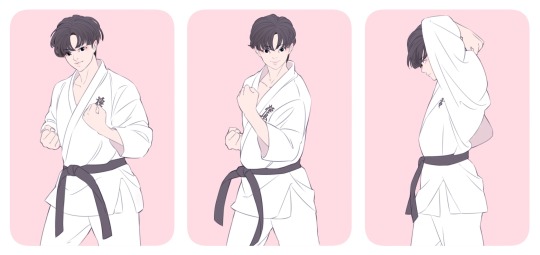
Application!
My bear assistant will help me explain the application of this elbow strike. It is a close range attack, therefore, the best way to use is when your opponent standing close to you!
For example, my assistant is grabbing my collar. I can easily step in and strike at his chin!
Bear assistant: Ouch! Don’t hit for real!
Yeonwoo: You have protection!
Bear assistant: You dipshit! Anyway, in case of a clinch and not a collar grab, when they put their hands around your neck, another way to go is the Roundhouse Elbow Strike to the temple. Instead of going from below, you strike from the side.

Part 2: Ushiro Hiji Ate (後ろ肘当て) - The Back Elbow Strike
The second elbow strike. It’s like a reversal of a straight punch! First, you prepare by making a punch at midsection, Chudan (step 1). Then, you will pull the arm towards your hip and strike the elbow to the opponent’s solar plexus, rib cages or tummy (step 2 and 3).
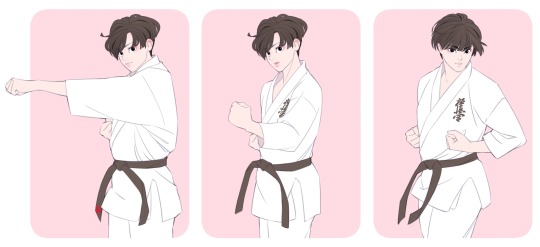
Application!
For example, my bear assistant will do a rear bear hug like this! This position is vulnerable. The attacker can try to take us to the ground, or they can lift us up and carry us somewhere…to kidnap!
Bear assistant: Hey, shortie.
Yeonwoo: The first step is to drop our centre of gravity and lean forward. Please don’t be afraid to head butt or strike the groin! When the arms are loosened, you can use the Back Elbow Strike. You can finish the attacker by more and more elbow strikes, whether it’s the Rising Elbow Strike, the Front Elbow Strike or the Roundhouse Elbow Strike!
Bear assistant: Fuck! Not again!

Part 3: Oroshi Hiji Ate (下ろし肘当て) - The Downward Elbow Strike
We will switch role because I trust him. ( ̄.  ̄|||)
The final strike! This time, you will strike downward, which usually ends below the belt - Gedan. But the Downward Elbow Strike can hit anywhere! The head, the shoulder, the back, the stomach, in @yoo-hobin’s fight, the foot!
First, you raise the arm up, and your other arm put in front of your chest (step 1). Second, you slam the elbow down directly on the target and your other arm pulled back (step 2 and 3).

Application!
This time, it’s my turn to attack! I will lift my assistant up to throw him down. This is the front bear hug. With knowledge of the downward elbow strike, what would he do?
Bear assistant: You want me to knee you in the balls and strike the elbow down your back?
Yeonwoo: Huh? What do you mean?
Bear assistant [PATS MY HEAD]: I’m not gonna do that. Now put me down!
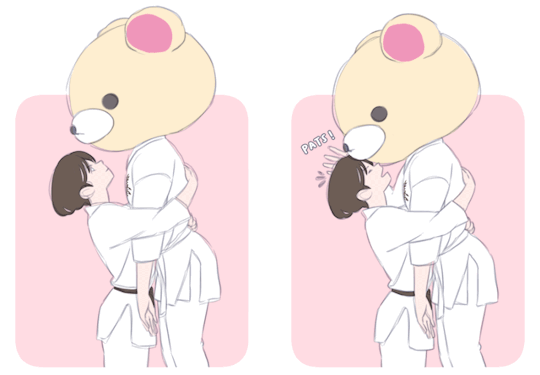
Personal note: T-The lesson is too long…I’m sorry. I didn’t expect myself to write this much…(ノ_<。)
☀️ Taehoon: In Taekwondo, we also have elbow strikes. The ones you taught today are Taekwondo’s Palgup Ollyo Chigi, Palgup Dwi Chigi and Palgup Naeryo Chigi. They’re banned in tournaments though.
📖 Yeonwoo: Will you teach them next time?
☀️ Taehoon: Let’s see…If they behave themselves.
That is all for my tutorial! Credits go to Sosai Oyama, my Sensei, my friend @taehoon-taekwondo and artist @eatsbop 🙇🏻🥋
Oh, I almost forgot! Happy Valentine’s Day! 💗
Bye bye everyone! I will see you, next time on my Kyokushin Karate Blog!
#肘当て#Elbow Strike#How to Fight#Karate#Author: Ji Yeonwoo#Artist: eatsbop#References: Sosai Oyama and my Sensei#Osu!
191 notes
·
View notes
Note
hope your healing is going well :)
It is! I’m so sorry I haven’t updated you all after that cryptic message lol.
So I had surgery on my arm to put a metal plate on my broken bone (Olecranon Fracture if anyone knows what that means). I thought being hurt would give me writing time but woah was I wrong. I’m very tired and can’t move my hand enough to type (using my phone rn).
So updates soon but not too soon on the fics
4 notes
·
View notes
Text
Personal Injury Potential Settlement Values: Arm Injuries
Arm wounds are regularly brought about by naturally holding out ones arm as a guarded activity not long before accident sway and at times because of the effect from air packs sent at touchy velocities. In this article, we will investigate four arm wounds and authentic instances of the personal injury settlement esteems casualties have gotten:
Separation of Elbow Joint
Monteggia Fracture: Anterior Dislocation of the Radial Head with Anterior Angulation of Fractured Ulnar Shaft
Colles Fracture
Comminuted Intra-Articular Fracture of the Olecranon
Separation of Elbow Joint Settlement Value
Separation of Elbow Joint
A separation of the elbow happens when the bones of the elbow move strange contrasted and the bone of the arm. Elbow separations are normally brought about by hard falls where the arm is broadened totally, just as engine vehicle accidents. Manifestations include: serious agony in the elbow, growing, and a powerlessness to twist the arm.
In 2008, the Court in Thorp v Gerow, 2008 BCSC 622 granted the harmed individual $50,000 for wounds that incorporated a disjoined elbow.
To peruse the full choice on CanLII, click here.

Monteggia crack front disengagement of the outspread head with foremost angulation of broke ulnar shaft Settlement Value
Monteggia Fracture: Anterior Dislocation of the Radial Head with Anterior Angulation of Fractured Ulnar Shaft
A crack of the lower arm including a separation of the outspread head and a break of the ulna. Monteggia breaks are most generally brought about by falls on an outstretched arm. Manifestations include: arm torment, expanding of the lower arm, distortion, growing of the hand, growing of the wrist, restricted scope of movement.
In 1996, the Court in Roy v Benvie, [1996] BCWLD 2293 granted the harmed individual $60,000 for wounds that incorporated a monteggia break.
To peruse the full choice on CanLII, click here.
Colles break Settlement Value
Colles Fracture
A Colles Fracture happens when the span bone in your lower arm breaks. The sweep bone reaches out from the elbow to the thumb. This crack is frequently brought about by an individual falling onto a hard surface while extending their arms to pad their fall. Basic side effects include: change in the shape or expanding of the lower arm directly over the wrist, failure to hold or lift substantial articles, and wrist torment.
In 2008, the Court in Guy v Toronto (City), [2008] OJ No 5126 granted the harmed individual $30,000 for wounds that incorporated a Colles Fracture.
To peruse the full choice on CanLII, click here.
Colles crack Settlement ValueComminuted Intra-Articular Fracture of the Olecranon
Includes a crack of the lower segment of the elbow and is regularly brought about by a fall or direct injury to the elbow, especially in engine vehicle accidents. Regular indications include: exceptional elbow torment, expanding over the bone, powerlessness to fix the elbow.
In 2004, the Court in Milnes v Burlington, [2004] OJ No 1407 granted the harmed individual $30,000 for different wounds that incorporated a crack of the olecranon.
To peruse the full choice on CanLII, click here.
Accepting the Settlement You Deserve
Individuals frequently accept that settlement esteem is generally controlled by the degree of the injury. While this is a factor, the main data is the manner by which the injury has affected your life. As such, what does the injury keep you from having the option to do and how can this influence you?
I urge you to see my video on how personal injury settlement esteems are resolved wherein I talk about, in more noteworthy detail, how casualties can get the pay they merit.
An intensive lawyer should set aside the effort to completely comprehend your particular circumstance, including your life and obligations when your accident, to guarantee you don't under-settle your case. By measuring each conceivable misfortune, you are bound to get a fair settlement that will assist with facilitating the money related weights that typically happen during recuperation.
On the off chance that you have supported an arm injury or other personal injury at another gathering's deficiency, kindly don't spare a moment to reach me and my group of experienced Ontario personal injury lawyers for a free interview at pacelawfirm.com.
1 note
·
View note